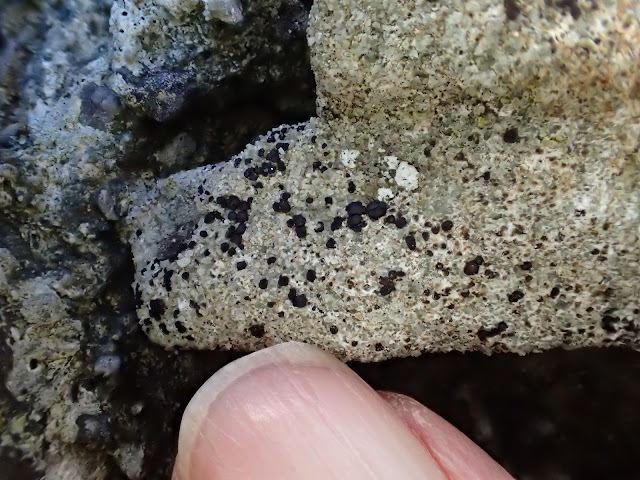Great How is an oak wood at the north end of Thirlmere. It is also a steep hill on all sides and must once have been an island in the glacier. It reaches 390m in height, The reservoir high water level at its foot is about 180m. The rocks are acid.
On Sat 18 December 2021 I met the group at 9.30. I had left Settle in fog, but the sky soon cleared. We were deep in the valley but it was obvious the sun would shine once it could get over the mountain tops. We listened to the safety talk about not falling into Thirlmere, and set off.
A big thank you to Pete Martin, Caz Walker and Chris Cant for leading the lichens group.
DO tell me if I have misidentified anything.
 |
| Peltigera praetextata in the frost |
 |
| The Moss people spent a long time at this damp bank right at the beginning |
 |
Baeomyces always enchants.
I was told this was B rufus - but why is it not Dibaeis baeomyces?
Guide des Lichens de France says of the apothecia
Dibaeis baeomyces - "en turban" (and pink) - like a round turban
B rufus - "en berét" (reddish to light brown) like a flat beret
|
 |
| A handrail prevents us falling into the reservoir |
 |
| In a vertical sheltered exposure in the cliff on the left we see Lepraria membranacea - the thallus is membranous and strongly delimited. The tips of the lobes curl up a little. It grows on shaded, vertical acid rocks, and also on mosses and shaded deciduous trees. |
 |
On the same sheltered vertical face is Opegrapha (formerly Enterographa) zonata - a new lichen for me. It has lilac punctiform soralia. It likes acid rock
(It looks a little bit like Opegrapha gyrocarpa, but that is much orangyer with light yellow to orange soralia) |
 |
| Opegrapha zonata seen closer |
 |
| A large earthball |
 |
pleasing fence posts
|
 |
| I just love the pattern |
 |
| I hope one of the bryologists will confirm that the liverwort with the brown dots is Scapania nemorea |
 |
| The brown dots are gemmae (A budlike mass of undifferentiated tissue which serves as a means of vegetative reproduction among mosses and liverworts. ) . Both leaf lobes are broadly
rounded, and usually edged with long, marginal teeth |
 |
| In the upper surface of the lower rail of the fence is this lichen which I think is Trapeliopsis flexuoxa |
 |
| Pertusaria hymenea |
 |
| I finally get down to the shoreline |
 |
| Looking across Thirlmere to Raven Crag |
 |
| A moss on one of the boulders at the shore |
 |
| The Bryologists catch up with us for Lunch. Shortly after this we the Lichens people take the "direct route" straight up the hill - Whilst the bryologists follow the gentle sloping path and overtake us. |
 |
| A moth |
 |
What is this foliose lichen? Look closer.. (When it dries this lichen is grey)
|
 |
| It is Cetrelia olivetorum - This is a new plant for me. Its nice and BIG - a bit like Platismatia-glauca - but look carefully and you see small scattered white dot-like pseudocyphellae. The margin of some of the thallus is covered in soralia The whole thallus covered a big area on the trunk |
 |
"The centre of the underside of the Cetrelia olivetorum has simple rhizinae and is black, becoming brown or smooth towards the lobe tips". This sentence is cribbed straight from Dobson. -Seventh revised Edition. Frank Dobson died last week - British Lichenologists owe him so much!!!! RIP and Thank you Frank.
|
 |
| Pachyphiale carneola - the red apothecia are tiny up to 0.5 mm across. They look like tiny red wine gums |
 |
Examining the Pachyphiale carneola
|
 |
| Perhaps Arthonia spadicia or A vinosa? |
 |
The bryophyte people reached the summit and then walked down to where we were. See the sunlight is retreating up the hill
|
 |
| Oh look!! |
I am still thinking about this one - above and below - that was growing in a soil bank
 |
| Here is some Bryoria fuscescens - on a fallen tree - that the leaders had found earlier on a previous trip and took us to see. |
Finally two red lichens to bring Christmas Cheer.
 |
| Mycoblastus sanguinius When a black apothecium is knocked of a red mark is left behind |
 |
| Cladonia floerkeana on a very old wood pile |
Do visit the Cumbria Lichens and Bryophytes Website.
The group welcomes new people including beginners. I would have missed many of these lichens if I had not had the others there to point them out! Oak woodland is an important habitat for lichens.
I saw six new "Lifers" for me. When the group sent me the species list of 68 lichens for the day there were actually another half dozen on the list that I missed that I have not seen!
Ah well, another day. The Lake District is such a good area for Lichens.






































































